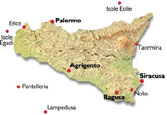|
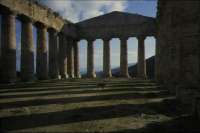 To visit Segesta at the optimum time, I left my hotel in Sciacca at 6 am, and drove with the dawn in the rear view mirror (genuinely lurid behind Rocca Nadore) past Menfi and along the deserted motorway to reach my destination at 7.15, in perfect weather, feeling very smug - only to find that the entire vast site is now enclosed by a 10 foot metal fence, and that the main gate does not open until 9! I did not follow the example of the athletic fungi-hunters, who vaulted over using an elastic thingy as a step: I am too old for some things. Instead I used cunning, and found an open gate about half a mile up the road to Calatafimi! To visit Segesta at the optimum time, I left my hotel in Sciacca at 6 am, and drove with the dawn in the rear view mirror (genuinely lurid behind Rocca Nadore) past Menfi and along the deserted motorway to reach my destination at 7.15, in perfect weather, feeling very smug - only to find that the entire vast site is now enclosed by a 10 foot metal fence, and that the main gate does not open until 9! I did not follow the example of the athletic fungi-hunters, who vaulted over using an elastic thingy as a step: I am too old for some things. Instead I used cunning, and found an open gate about half a mile up the road to Calatafimi!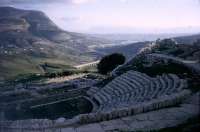 I followed the long winding road up to the theatre, with superb views of the temple and its setting all the way. The theatre is compact, and superbly sited, as all Sicilian Greek theatres seem to be. This one is the most spectacular however, with view to the mountains opposite with the Gulf of Castellemare to the right - and the motorway snaking across the valley. I was joined by a friendly dog (there always seems to be one - see Vendicari) and made my way to the theatre - the climax of the visit. Fido and I had the site to ourselves (the fungi-gatherers had long since completed their mission), as the sun rose and warmed the columns. The first trippers arrived at 9.30, just as I was leaving. I followed the long winding road up to the theatre, with superb views of the temple and its setting all the way. The theatre is compact, and superbly sited, as all Sicilian Greek theatres seem to be. This one is the most spectacular however, with view to the mountains opposite with the Gulf of Castellemare to the right - and the motorway snaking across the valley. I was joined by a friendly dog (there always seems to be one - see Vendicari) and made my way to the theatre - the climax of the visit. Fido and I had the site to ourselves (the fungi-gatherers had long since completed their mission), as the sun rose and warmed the columns. The first trippers arrived at 9.30, just as I was leaving.
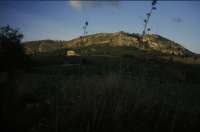 Segesta (called Egesta by the Greeks) was the chief city of the Elymians. Its founder was traditionally Acestes, who also ruled Eryx, although Virgil makes Aeneas its founder. Despite evidence of early contact with Greek Selinus, their neighbour to the south (Greek pottery imports, and using the Greek alphabet to write their language), the two cities became implacable enemies - which led to Segesta's alliance with Athens (458 BC). There were at least three wars between the two states - the last one being in 416, when the Athenians were called in to help under the old alliance. According to Thucydides, they fooled the Athenian ambassadors into believing theirs was a city of unbounded wealth, by recycling their limited supply silverware between the various houses where the visitors were entertained. Segesta (called Egesta by the Greeks) was the chief city of the Elymians. Its founder was traditionally Acestes, who also ruled Eryx, although Virgil makes Aeneas its founder. Despite evidence of early contact with Greek Selinus, their neighbour to the south (Greek pottery imports, and using the Greek alphabet to write their language), the two cities became implacable enemies - which led to Segesta's alliance with Athens (458 BC). There were at least three wars between the two states - the last one being in 416, when the Athenians were called in to help under the old alliance. According to Thucydides, they fooled the Athenian ambassadors into believing theirs was a city of unbounded wealth, by recycling their limited supply silverware between the various houses where the visitors were entertained. 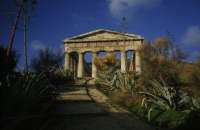 The Athenian defeat in 415 at the hands of Syracuse scotched any hopes of actual assistance from that quarter. The sack of Selinus by Hannibal in 409 should have been good news for Segesta - but she was forced to become a subject of Carthage. In 307 BC Agathocles captured the city, and treated its inhabitants with exceptional unpleasantness, forcing a name change to Dikaiopolis. Luckily the Romans approved of them, and restored their name - thanks to their presumed shared Trojan ancestry, and the Segestans did well for a time. Eventually the site was abandoned, though, and it remained mostly uninhabited from the 3rd century AD until the present. The Athenian defeat in 415 at the hands of Syracuse scotched any hopes of actual assistance from that quarter. The sack of Selinus by Hannibal in 409 should have been good news for Segesta - but she was forced to become a subject of Carthage. In 307 BC Agathocles captured the city, and treated its inhabitants with exceptional unpleasantness, forcing a name change to Dikaiopolis. Luckily the Romans approved of them, and restored their name - thanks to their presumed shared Trojan ancestry, and the Segestans did well for a time. Eventually the site was abandoned, though, and it remained mostly uninhabited from the 3rd century AD until the present.
Apart from the theatre, the main objective is the 5th century temple - it never had a roof, and the fluting of the columns was never completed. Various explanations have been offered - was the temple begun as part of the exercise to gull the Athenians (and thus there was no need to finish it once aid was promised) or was it that the Elymians worshipped in roofless temples and it was never intended to have one? Both ideas seem far-fetched; we just don't know.
The temple at Segesta is fondly recalled by New York mobster Joseph "Joey Bananas" Bonanno in his memoirs:
"The colour of the temple would change with the progress of the sun from a soft gold at noon to a bronze at sunset. On rainy days, I would roam the temple grounds foraging for snails, which my grandmother fried in garlic."
Click for more recent pictures (2007) of Segesta on my Flickr page
|

